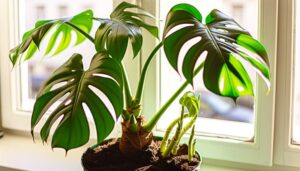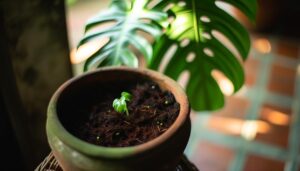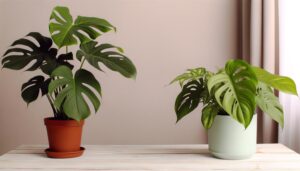Caring for an Monstera Obliqua
To care for a Monstera obliqua, make sure it receives bright, indirect light to mimic its natural habitat. Keep humidity levels around 80% using a humidifier or misting and maintain temperatures between 65-80°F.
Water every 7-10 days, making certain the soil is well-draining and rich in organic matter to prevent root rot. Use a balanced liquid fertilizer diluted to avoid root burn every 4-6 weeks.
Regularly check for pests on its thin leaves and use insecticidal soap if needed. Prune yellowing leaves with sterilized shears and repot every 1-2 years.
Discover more nuanced details for thriving growth.
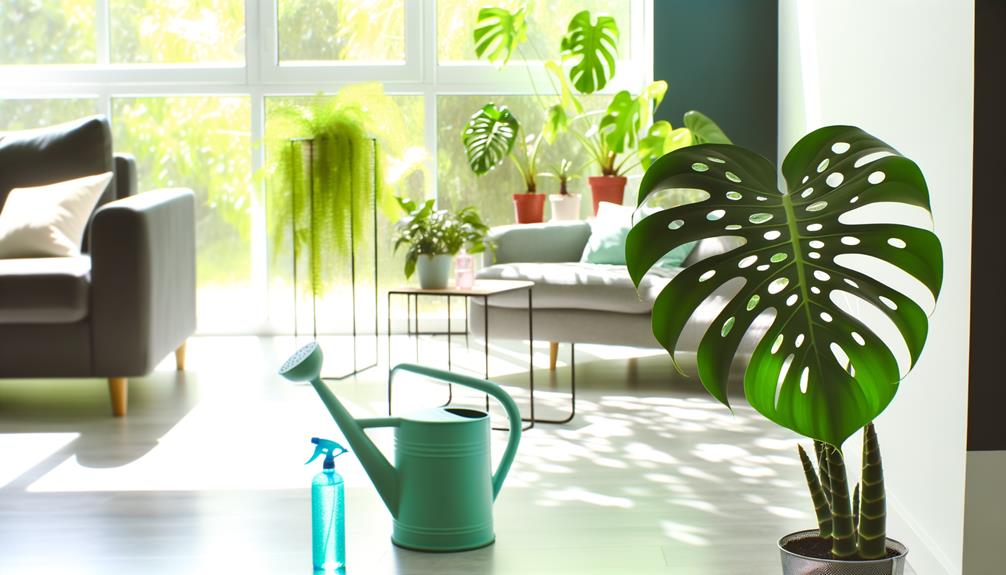
Key Takeaways
- Place the plant in bright, indirect light to mimic its natural habitat.
- Maintain high humidity levels around 80% to prevent leaf dehydration.
- Water every 7-10 days, ensuring the soil is well-draining to avoid root rot.
- Apply a balanced liquid fertilizer every 4-6 weeks, diluting to prevent root burn.
- Regularly inspect for pests and use insecticidal soap or neem oil as needed.
Understanding Monstera Obliqua
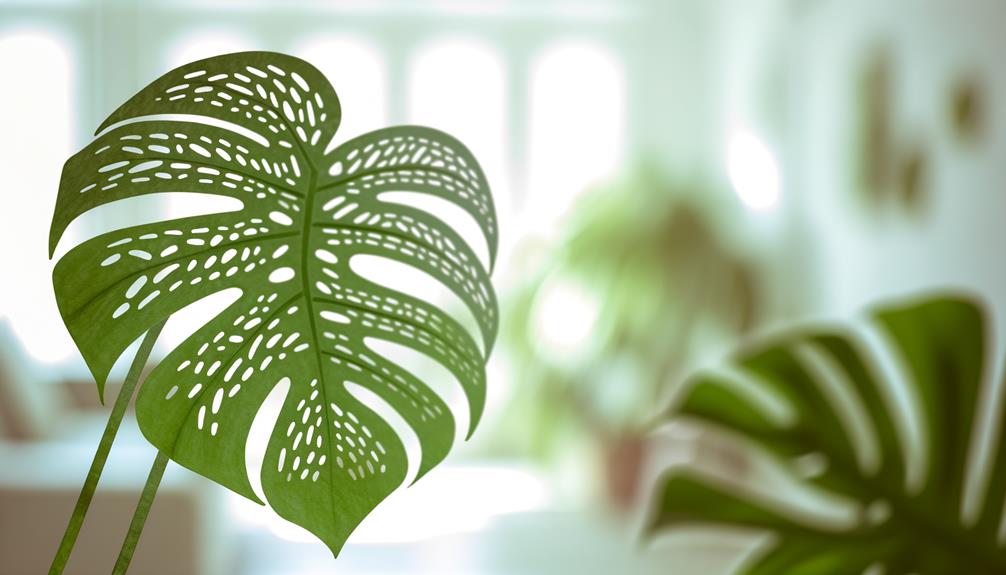
Understanding Monstera obliqua requires recognizing its distinctive features, such as its delicate, fenestrated leaves and its preference for high humidity and indirect light.
The leaves are thin, almost papery, with extensive perforations, making them a standout among Monstera species. To thrive, this plant needs an environment mimicking its native tropical habitat.
Maintain the humidity levels are consistently high—around 80%—to prevent leaf dehydration. Soil should be well-draining yet moisture-retentive, rich in organic matter. Regularly check for pests, as the thin leaves can be susceptible.
You should also consider using a humidity tray or a humidifier to maintain ideal conditions. By understanding these specific requirements, you can create a conducive environment for Monstera obliqua to flourish.
Ideal Light Conditions
You should place your Monstera Obliqua in an area where it can receive bright, indirect light to achieve ideal growth. Direct sunlight can cause leaf burn, so it's essential to shield the plant from harsh rays.
Using a sheer curtain or positioning it near a north-facing window can help strike the right balance.
Bright, Indirect Light
For optimal growth, Monstera Obliqua requires bright, indirect illumination, mimicking the dappled sunlight of its natural rainforest understory. Place your plant close to a north or east-facing window where it can soak up abundant light without direct sun exposure.
Insufficient light will result in reduced growth and smaller, less fenestrated leaves. On the contrary, excessive indirect light won't damage your plant but may accelerate water evaporation, necessitating more frequent watering. Use light, gauzy drapes to soften harsh light if needed.
Furthermore, rotating the plant regularly guarantees uniform light dispersion, fostering even growth. Applying these techniques will enhance your Monstera Obliqua's photosynthesis process and overall well-being.
Avoid Direct Sunlight
Protecting your Monstera Obliqua from direct sunlight is crucial, as intense rays can scorch its delicate leaves and hinder its growth. Position your plant in a spot where it receives bright, indirect light, such as near a north or east-facing window.
Direct exposure to sunlight can lead to leaf burn, characterized by brown or yellow patches. Utilize sheer curtains to diffuse light if necessary. Monitor the light levels with a light meter to ensure ideal conditions, aiming for 10,000 to 20,000 lux.
Adjust positioning seasonally, as the sun's intensity varies. Artificial grow lights can supplement natural light, maintaining a consistent photoperiod. Balancing light exposure will promote healthy foliage and robust growth for your Monstera Obliqua.
Temperature Requirements

To guarantee your Monstera Obliqua thrives, maintain a stable temperature range between 65-80°F.
It's essential to avoid sudden temperature fluctuations, which can stress the plant and hinder its growth.
Monitor indoor conditions closely, particularly near windows and heating or cooling vents.
Ideal Temperature Range
Maintaining a consistent temperature range between 65°F and 80°F is crucial for the best growth and health of your Monstera Obliqua. This range mimics the tropical environment native to these plants, promoting efficient metabolic processes. Temperatures below 65°F can slow growth, while those above 80°F may stress the plant. Monitoring and controlling your indoor climate is key.
Here's a breakdown of the temperature effects:
| Temperature Range | Impact on Plant | Recommended Action |
|---|---|---|
| Below 65°F | Growth slows | Increase warmth |
| 65°F – 70°F | Optimal growth | Maintain |
| 71°F – 75°F | Ideal growth | Maintain |
| 76°F – 80°F | Acceptable | Monitor closely |
| Above 80°F | Stressful | Cool environment |
Carefully manage your Monstera Obliqua's temperature to ensure its well-being.
Avoiding Temperature Fluctuations
Ensuring your Monstera Obliqua isn't exposed to sudden temperature changes is vital for preventing stress and maintaining its overall health. These plants thrive in stable environments, ideally between 65-80°F (18-27°C).
Rapid fluctuations can cause cellular damage, leading to leaf discoloration and reduced growth. You should position your Monstera away from drafts, air conditioning vents, and heaters. Consistency in temperature helps the plant maintain its metabolic functions efficiently.
Monitoring the ambient conditions with a reliable thermometer is pivotal. If your home experiences significant temperature swings, consider using a room humidifier or heater to stabilize the environment.
Humidity Levels
Proper moisture levels play a crucial role in the health and vitality of your Monstera Obliqua. These tropical plants thrive in environments with high moisture content. Aim to maintain relative moisture levels between 60-80% for peak growth.
You can achieve this by using a humidifier, placing your plant on a pebble tray filled with water, or misting the leaves regularly. Monitor the moisture with a hygrometer to ensure consistency. Low moisture can lead to browning leaf edges and reduced growth.
Conversely, maintaining high moisture levels encourages lush, vigorous foliage and overall plant health. Regularly check for signs of low moisture and adjust your methods accordingly to provide the ideal conditions for your Monstera Obliqua.
Watering Schedule
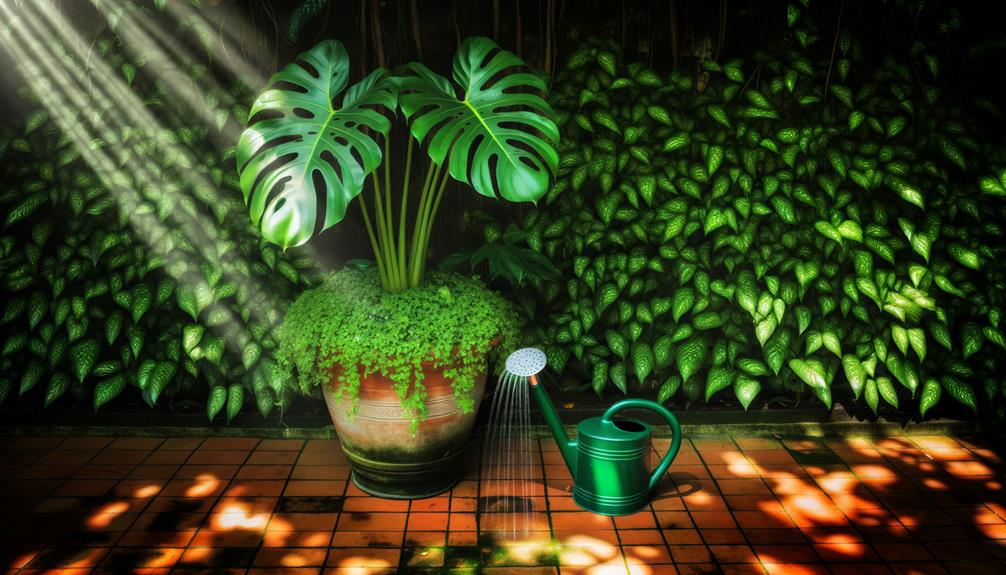
You'll need to establish a best watering frequency based on your Monstera Obliqua's environment. Typically, watering once a week suffices, but adjust for humidity and light levels.
Be vigilant for signs of overwatering, such as yellowing leaves and root rot.
Optimal Watering Frequency
Monitoring the soil moisture level is crucial to determining the best watering frequency for your Monstera Obliqua. Use a moisture meter to get precise readings; the soil should be moderately moist but not waterlogged.
Typically, you'll find that watering every 7-10 days is ideal, but this can vary based on environmental conditions. Make sure the top 1-2 inches of soil dry out before watering again. Avoid letting the plant sit in water, as this can lead to root rot.
Adjust your schedule based on seasonal changes; water less frequently in cooler months and more in warmer, drier periods. Employing this method guarantees your Monstera Obliqua receives consistent hydration without the risk of overwatering.
Signs of Overwatering
Overwatering your Monstera Obliqua can be identified by several key indicators, which, if not addressed promptly, can lead to severe plant health issues.
First, check for yellowing leaves; this often indicates that the roots are suffocating due to excess water.
Next, examine the soil: if it's constantly wet and emits a sour odor, that's a clear sign of root rot.
Additionally, inspect the leaves for brown patches or wilting, which suggest waterlogged roots.
To confirm, gently lift the plant from its pot and examine the roots; healthy roots are white, while overwatered roots appear brown and mushy.
Adjust your watering schedule immediately if you notice any of these symptoms to prevent long-term damage.
Soil Preferences
A well-draining soil mix rich in organic matter is essential for ensuring the best health and growth of your Monstera Obliqua. You'll want to use a combination of peat moss, perlite, and orchid bark to achieve this. Here's a breakdown of the benefits:
| Component | Benefits |
|---|---|
| Peat Moss | Retains moisture and nutrients |
| Perlite | Enhances drainage and aeration |
| Orchid Bark | Promotes root growth and structure |
Fertilization Tips
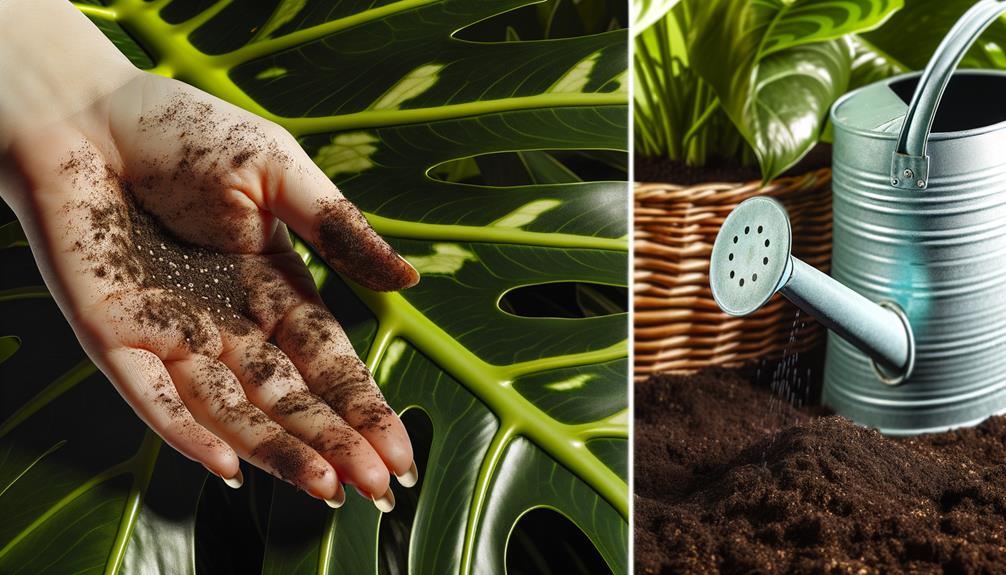
In addition to providing the right soil mix, you'll need to apply a balanced liquid fertilizer every 4-6 weeks during the growing season to guarantee your Monstera Obliqua receives the necessary nutrients for best growth. Opt for a fertilizer with an equal N-P-K ratio, such as 20-20-20, to maintain a balanced nutrient supply.
Dilute the fertilizer to half the recommended strength to prevent root burn and nutrient overload. Pay attention to any signs of nutrient deficiency, such as yellowing leaves, which may indicate the need for adjustment. Always water the plant before and after applying the fertilizer to help distribute nutrients evenly and avoid root damage.
Regular monitoring and adjustments will help maintain peak growth and health.
Pruning Techniques
Pruning your Monstera Obliqua is essential for promoting healthy growth and preventing overcrowding, ensuring each leaf receives adequate light and air circulation.
Start by sterilizing your pruning shears to prevent disease transmission. Identify any yellowing or damaged leaves and remove them at the base, using a clean, angled cut.
Target overgrown stems that disrupt the plant's symmetry. Focus on cutting just above a node where new growth can emerge. Regularly inspect and trim aerial roots that may compete for nutrients.
Prune during the growing season, typically spring or early summer, to optimize recovery. Avoid excessive pruning; removing more than 25% of the foliage can stress the plant. This careful approach encourages a robust, aesthetically pleasing Monstera Obliqua.
Pest Management
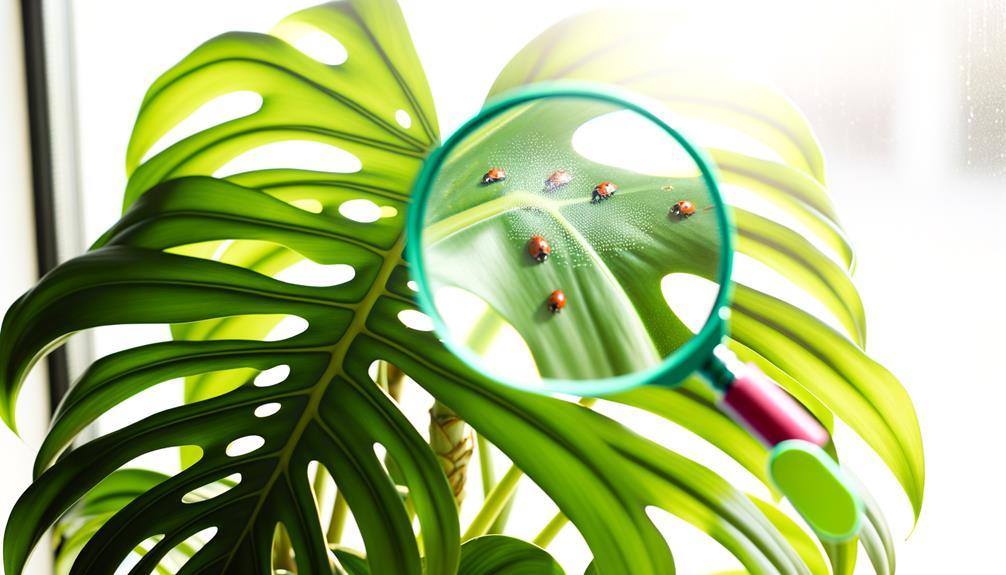
Managing pests on your Monstera Obliqua involves identifying common invaders like spider mites, mealybugs, and scale insects, and implementing targeted treatments to protect the plant's health. First, examine your plant regularly for signs of infestation, such as webbing, sticky residue, or discolored leaves.
Here are some effective pest management techniques:
- Isolate the Infected Plant: Prevent pests from spreading to other plants.
- Mechanical Removal: Use a cotton swab dipped in alcohol to remove visible pests.
- Insecticidal Soap: Apply according to the manufacturer's instructions for effective results.
- Neem Oil: A natural pesticide that disrupts pest feeding and reproduction.
- Maintain Humidity Levels: Pests like spider mites thrive in dry conditions, so keep humidity high.
Common Diseases
Spotting common diseases in your Monstera Obliqua early can prevent significant damage and secure the long-term health of your plant. Look for signs of root rot, which often manifests as yellowing leaves and mushy roots. This typically results from overwatering or poor drainage.
Fungal leaf spots, appearing as brown or black patches with yellow halos, indicate a need for improved air circulation and less leaf moisture. Bacterial blight, characterized by water-soaked lesions, requires immediate removal of affected areas and reduced humidity.
Additionally, powdery mildew, identifiable by a white, powdery substance on leaves, necessitates prompt treatment with fungicidal sprays. Regularly inspect your plant, maintain optimal watering practices, and ensure adequate ventilation to minimize disease risks effectively.
Repotting Guidelines

Repotting your Monstera Obliqua every one to two years guarantees it has ample space for root growth and access to fresh, nutrient-rich soil.
You'll need a pot that's 2-3 inches larger in diameter than the current one. Confirm the new pot has adequate drainage to prevent waterlogging. Use a well-draining, peat-based potting mix to support healthy root development.
When repotting, be gentle with the roots to avoid damage. Water the plant thoroughly after repotting to help settle the soil.
- Timing: Early spring, before active growth begins.
- Tools: Clean scissors, new pot, and fresh potting mix.
- Procedure: Remove plant, trim unhealthy roots, place in new pot.
- Soil: Well-draining, rich in organic matter.
- Post-care: Monitor for signs of stress, water as needed.
Propagation Methods
To propagate your Monstera Obliqua effectively, you'll need to comprehend the key techniques such as stem cuttings and air layering. Stem cuttings involve trimming a healthy stem with at least one node and placing it in water or damp soil until roots develop. Air layering requires injuring a section of the stem, applying rooting hormone, and wrapping it with damp sphagnum moss and plastic wrap until roots form.
Here's a visual representation of the methods:
| Technique | Key Steps |
|---|---|
| Stem Cuttings | Trim stem, place in water or soil, wait for roots |
| Air Layering | Injure stem, apply hormone, wrap with moss and plastic |
Understanding these methods guarantees healthy propagation and growth, optimizing your plant's potential.
Conclusion
In caring for your Monstera obliqua, you've got to mind the light, temperature, and humidity, keeping them just right.
Water it judiciously and keep an eye out for pests and diseases as if you were a vigilant gardener.
Repot when necessary and propagate with precision.
Remember, tending to this plant is like conducting an orchestra; every element must be in harmony for a beautiful outcome.
Happy growing!

